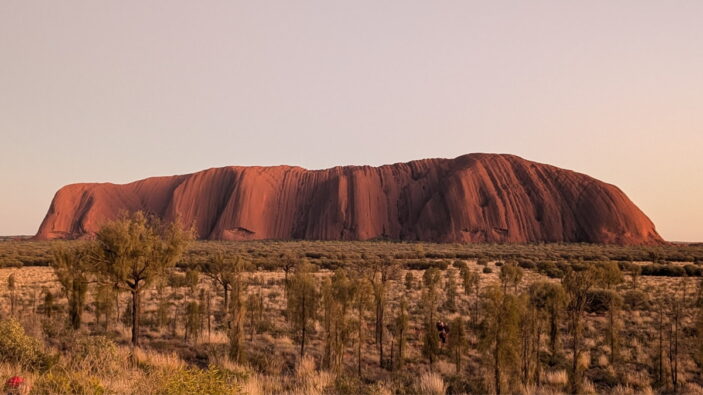
The era of the climb is over, but Uluru’s array of dazzling cultural experiences has made it an even more vital destination for all Australians.
It’s not every day the world’s longest surviving culture invites you into its home, but here I am. Layered-up in a laundry-load of clothes, my breath fails to cloud despite the lonely, single Celsius registered in the mercury. It’s that dry. It’s also silent; as if the land is holding its breath in anticipation for the day ahead. A moment of everything and nothingness all at once. It’s intoxicating.
I’ve rarely felt so alive, and I dare not blink as I try to take in the scene before me.
A sky filled with stars falls from black, to purple, to violet. Then orange, yellow and red. Just enough sun is poking its head over the horizon to etch the iconic Uluru into shape. The land. The Aṉangu.
Then the show begins.
Misunderstanding Uluru
It’s my third time in the red centre, but – I realise on reflection – it’s my first time in rhythm with the spiritual heart of Australia.
On my first visit it was all about the climb. Whether it was ignorance or naivety, or simply a byproduct of my 1980’s public school education, that’s what I thought Ayres Rock (sic) was all about. A hike. A climb. Something to conquer.
When it became evident that the experience was going to end in October 2019, I joined the 1200 tourists an hour trying to scurry to the top and plant my little flag before it was too late. As if Uluru was about to be taken away from us forever and it was my last chance to properly “do it.”
The second time I went it was a work trip and I was given a long list of things I couldn’t do. No photos of this; no video of that; no drones anywhere. All the while I was sold a product, a vacuum cleaner, with Uluru emblazoned across its banner. It left me jaded and frustrated; as if it was all about money and control.
No wonder it seemed deserted. The 1200 people an hour meandering at the bottom of the scar dwindled to a dozen.
The real Uluru climb
On this third visit, I climbed Uluru once again. This time, however, it hasn’t been an act of physical exertion that had me on top of the world, but of metaphysical reflection. I’ve come to see Uluru in a way I had never expected. In a way the Aṉangu have for tens of thousands of years.
Upon reaching the summit I awoke, but this isn’t woke commentary. It’s merely where I ended up, personally, as I immersed myself in a series of cultural experiences put together by Voyages alongside the traditional owners of the land, the Aṉangu. And listened to what they had to say.
It started with a subtle change in thinking I didn’t even notice. I stopped asking “what” the rules were, and started asking “why.” There’s no shortage of people out there happy to explain, too. With a passion and willingness that defies what must have been many years of frustration.
When I ask local artist Denise Brady how it felt to have people see her art with Uluru in the background, I was expecting some movie script answer. A white answer. About its power enlightening her art or its wondrous presence making her canvas complete. But her reply was far more eye-opening. “It’s always been there,” she shrugged, wondering why such a thing would matter, “and so have we.”
Indigenous culture
There is no separation between the land, the art, the story, the people and even time itself. They are all tjukuṟpa and are all Aṉangu. Her answer shoved me past a subconscious barrier; the one where I was trying to understand her culture through a European lens. Trying to find the deeper layers my city-centric mindset asserts upon reality to give it meaning; to instead accept what was in front of me for what it was.
Through the art and cultural experiences that now take centre stage at Uluru, I felt more connected to my country than I ever did standing at the top. Looking down on the land, rather than upon it.
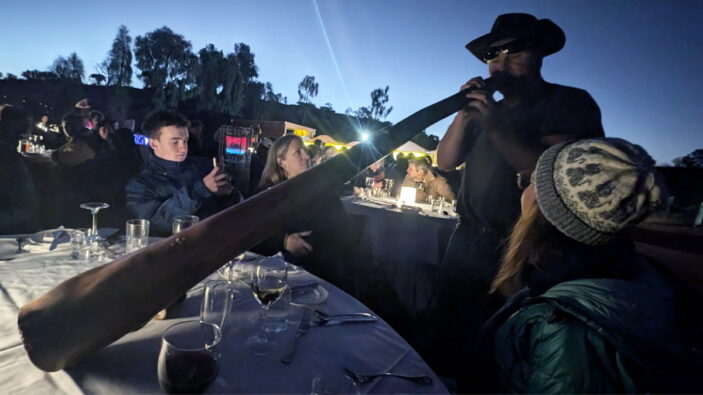
Ancient stories with a modern twist
It’s Voyages Indigenous Tourism Australia that has been tasked with ensuring Uluru remains an essential destination for both domestic and international tourists in the post-climb era. A task that, at its core, must reflect the wishes of the traditional owners of the land, the Aṉangu. That wish? To share their story and help visitors understand their culture: their land.
You can still take the camel rides, scenic helicopter flights and wander the field of light. There’s no shortage of hikes, bike rides and even Segway routes. Uluru itself is a landmark of such unique scale and significance that simply seeing it, and feeling its power, is worth the trip alone.
But it’s the growth in cultural experiences intimately linked to the natural wonders that have consigned “the climb” to history.
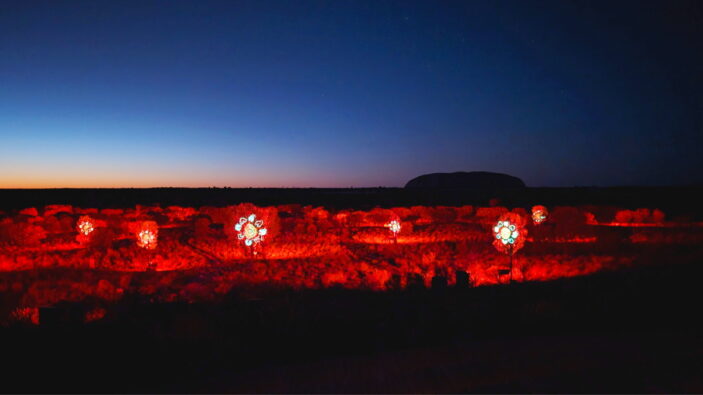
Uluru Sunrise Journeys Review:
This two-hour Sunrise Journeys experience starts early, well before the sun rises. A short bus trip takes you from your Ayres Rock Resort accommodation to a subtle, but spacious, platform that overlooks the Spinifex towards Uluru.
Warm lemon myrtle tea and muffins greet your freezing fingers on arrival; make sure you dress warm. The sun slowly begins to creep over the horizon and then the art surfaces. You’ll witness a laser and light show put together by MandyLights, which projects and animates a piece of Indigenous art onto the surrounding country.
The art is called Ngura Nganampa Wiru Mulapa, which translates from Pitjantjatjara to “Our Country is truly beautiful.” It’s the creation of three local Aṉangu women; Selina Kulitja (Maruku Arts), Denise Brady (Kaltukatjara Art) and Valerie Brumby (Walkatjara Art). It’s narrated by Denise Brady, who helps interpret the story in the art to visitors, all to the striking background music of Aṉangu musician, Jeremy Whiskey.
Sunrise Journeys is an emotional experience, seeing the story of the land unfold on the very land itself. The sky ever-changing as the sun rises, producing a stunning natural canvas that may include Uluru, yet somehow doesn’t make it the focus.
When the show ends, there are many heartbeats of silence as viewers reflect and soak it all in. This is followed by a small, but delicious breakfast inspired by, and often including, local ingredients. The best Uluru sunrise experience, for sure.
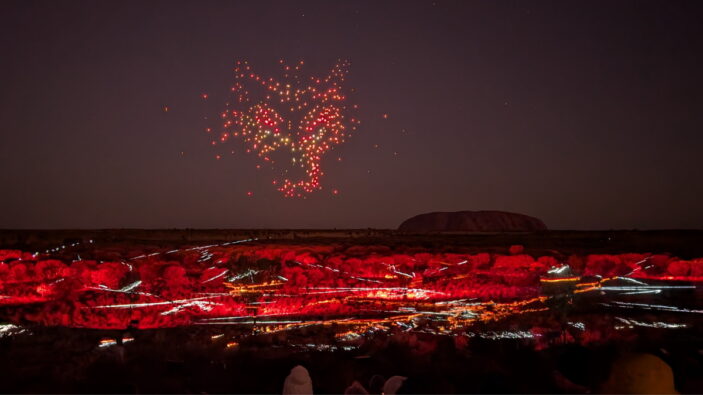
Wintjiri Wiru Review:
At the end of the day, the sunset does its best to match the spectacular sunrise and it’s a close call: you won’t want to miss either. The Wintjiri Wiru is a true wonder and an experience unlike any other in the world. It uses up to 1200 drones, 7 projectors and 6 lasers to reinterpret the Aṉangu’s Mala story into an ultra-modern, yet organic light show.
In combination with Aṉangu songs and narration in both Pitjantjatjara and English, this story blends into the stars as the sun sets, creating a piece of art that moves and lives in the land itself. While the drones dominate the sky, the projectors and lasers also light up the land and trees, giving you a 180-degree experience that comes to a close as the final rays hit Uluru.
It’s a phenomenal and emotional experience that you’ll never forget.
Wintjiri Wiru unfolds on the same platform as Sunrise Journeys, just outside the Ayres Rock Resort. It can be experienced in two forms. There’s a Sunset Dinner, whereby you arrive early and enjoy drinks (cocktails made from indigenous distilled gin, indigenous beers, wine and bubbles) and local ingredient-inspired canapes. You’ll also get a huge hamper filled with delicious food, all heightened by the taste of local ingredients.
Alternatively, you can turn up just for the light show itself. This is called the Twilight package.
Note: As custodians of the land, Aṉangu hold the Mala story from Kaltukatjara to Uluru. To share their story, RAMUS designed and produced an artistic platform using drones, light and sound to create an immersive storytelling experience.
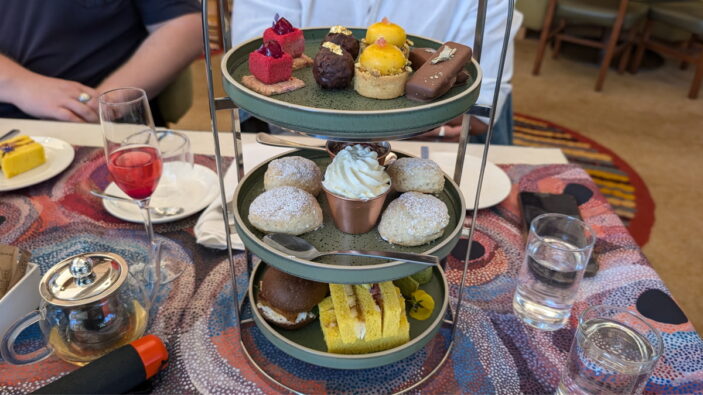
Uluru Australian Native High Tea Review:
If you’re feeling peckish after a sunrise Uluru experience and a morning walk around the Uluṟu-Kata Tjuṯa National Park, there’s quite the culinary experience available at Sails in the Desert.
The Australian Native High Tea is a new initiative, weaving local ingredients together in unexpected ways to take you on a culinary adventure. They’re presented beautifully, starting with savoury and rising to sweet, and there’s no way you’ll walk away hungry at the end.
I was particularly fond of the Uluru saltbush caramel tim tam, the wild rosella flower mousse, the Barossa smoked chicken wrap and the prosciutto anise myrtle fig and brie finger sandwich. But it’s all good.
These are paired with your choice of six different teas supplied by indigenous company Blak Brews. There’s quite a selection of unique flavours that not only look incredible, but taste. Desert Sunrise and Red Centre were my picks. You can enjoy a few of these if you desire, and end it all with some hibiscus-infused prosecco.
Open invitation
I was invited to experience Uluru and these cultural experiences by Voyages and the Aṉangu, and so are you. It’s an open invitation. Depending on your resources, you can choose to stay cheap – there’s a camping ground and the backpacker-like Outback Hotel and Lodge, as well as an IGA for self-cooking. Then you can spend your money on experiences like those above.
They aren’t cheap to be fair, and that will sadly be a barrier to entry for many. It’s disappointing there’s no saving to be found with a family ticket. In fact, kids should be free in my opinion. But they remain worth it.
Alternatively, you can go all in. There’s more luxurious accommodation at places like Sails in the Desert and the Dessert Gardens Hotel. I can vouch for both of them.
I was taken by surprise by my moments of self-discovery on this trip. The Aṉangu made me proud to be an Australian and I feel that experiences like the ones mentioned above have started a new era for Uluru. An era of understanding.
